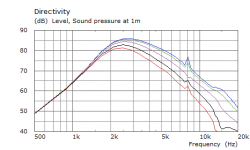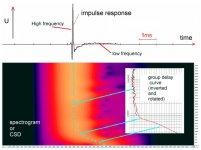I think the intention of the OSWG is to have a uniform SPL over a range of angles. If you want flat on axis and strong off axis low frequency response, then it would be a different shape where the beam will narrow with frequency.
Yes I look for an extreme beam nearly as in heterodyne speakers. It could be CD if possible 😉
This is an overlapped sim/measurement posted last year.
Original posting is here.
http://www.diyaudio.com/forums/multi-way/103872-geddes-waveguides-319.html
The geometry model was later refined and the match was a bit closer.
An externally hosted image should be here but it was not working when we last tested it.
Original posting is here.
http://www.diyaudio.com/forums/multi-way/103872-geddes-waveguides-319.html
The geometry model was later refined and the match was a bit closer.
I think the intention of the OSWG is to have a uniform SPL over a range of angles. If you want flat on axis and strong off axis low frequency response, then it would be a different shape where the beam will narrow with frequency.
The problem seen on-axis for the OS waveguides that I make are not the result of the contour, but of the mouth. Changing the contour will not fix the problem, but changing the mouth will.
This is an OS with a narrower profile, curves are with simple equalization. An OS profile was also used to make it blend with a baffle, but the baffle was not put on there during this measurement.
http://www.diyaudio.com/forums/multi-way/103872-geddes-waveguides-225.html#post1758752
And overlapped with sim without equalization
http://www.diyaudio.com/forums/multi-way/103872-geddes-waveguides-225.html#post1758752
And overlapped with sim without equalization
An externally hosted image should be here but it was not working when we last tested it.
Last edited:
The problem seen on-axis for the OS waveguides that I make are not the result of the contour, but of the mouth. Changing the contour will not fix the problem, but changing the mouth will.
I'm happy we've come so far at least – but to be more precise – I think it's not the case that the on-axis irregularity is a result of the "mouth reflections" only.
Rather this on-axis sound field defects are inherent to conicals and derivats (like the OS) - at least *all* my simus where a conical contour is partly involved show that issue of on-axis wiggles that smooth out greatly ~15deg off axis and up.
Heavy rounding of the mouth isn't as effective as to support your statement either :
http://www.diyaudio.com/forums/multi-way/140190-jean-michel-lecleach-horns-10.html#post1924924
Given above, I highly respect the results soongsc got with his attempts. You are ready to sell your horns soongsc ? – are they available in the meantime ?
Michael
Last edited:
Inverted dome, but not focal.Focal inverted dome as driver?
No. Currently they still don't sound good enough. I suspect some sort of phase plug might be necessary, and I'm also expecting a change in driver design. There has been lots of talk about the sidewalls and HOMs, and lips. It seems that each has it's pros and cons.... You are ready to sell your horns soongsc ? – are they available in the meantime ?
Michael
No. Currently they still don't sound good enough. I suspect some sort of phase plug might be necessary, and I'm also expecting a change in driver design. There has been lots of talk about the sidewalls and HOMs, and lips. It seems that each has it's pros and cons.
For a passive XO and EQ'ing it might be tricky but for an active system this contour should turn out pretty well - no?
How deep can you XO them realistically ?
Michael
Currently, listening tests have only been done stand alone without woofers. I'm not sure what you mean by "how deep", but the sound coloration is still too much below 4KHz. Impedance smoothing improves the situation a bit, but the main source seems to be horn loading. This is a very interesting issue.
Jean-Michal made me aware of the impact of group delay at the lower end of horns -depending on contour the sonic effect can be quite pronounced.
My contour is no exception here - no wonder is it developed out of JMLK's work. Either I have to stay seriously above those frequencies that modulate the honk - as is the only choice I see at the moment when going passive XO - or I go for electronic compensation .
Have you experimented in that direction too?
Michael
My contour is no exception here - no wonder is it developed out of JMLK's work. Either I have to stay seriously above those frequencies that modulate the honk - as is the only choice I see at the moment when going passive XO - or I go for electronic compensation .
Have you experimented in that direction too?
Michael
I have been thinking about a bass horn to integrate with the upper horn, but have not been able to figure out something that will look good and sound good without breaking the wallet. So that kind of design would probably have to go into a large speaker. I hear lots of people talk about group delay, but honestly, I don't have a good feel how the math definition relates with physical phenomena and how it relates with listening impressions. I'm just used to looking at phase.
Interesting - how do you get a good handle on horn loading? by listening ? by simu ? by measurement ?
Michael
Michael
Acoustic impedance in simulation is one aspect, but I'm not sure how good AxiDriver is at that. It's obvious in the CSD there is a significant difference between the raw driver and horned driver. Of course this is also audible and you hear unatural timbre in certain instruments.
I hear lots of people talk about group delay, but honestly, I don't have a good feel how the math definition relates with physical phenomena and how it relates with listening impressions. I'm just used to looking at phase.
Hello Soongsc
You'll find here attached a graph swowing in its upper part a screen copy of a measured impulse response , in the lower part of the graph you can see a spectrogram (this is equivalent to a CSD graph) using the same time scale and in the small window on right you can see a group delay curve obtained by derivation of the phase response of that impulse response.
As evryone can see, in a small interval of frequency the group delay as calculated is equivalent to the delay after which the wave group inside this interval of frequencies arrives.
So imagine a horn having 1 meter group delay at 600Hz and a group delay of 10 centimeter at 1200Hz and 1centimeter at 1800Hz and 1 millimeter at 2400Hz. Then take a signal with a fundamental at 600Hz and its harmonics H2, H3, H4.
The upper harmonics will arrive before the lower harmonics and before the fundamental. The shape of the signal will then be distorted. Many audiophile are sensible to that kind of distortion.
Best regards from Paris, France
Jean-Michel Le Cléac'h
Attachments
Last edited:
Hello Jean-Michel,
I understand how time delay effects sound. Since the definition of group delay is "-d (phase)/ d (frequency)", this means the phase would have to have a constant slope throughout the audio bandwidth. In reality, any device that is band limited will have a varying phase response associated with the frequency response. So is it even theoretically possible to obtain a constant phase slope?
I understand how time delay effects sound. Since the definition of group delay is "-d (phase)/ d (frequency)", this means the phase would have to have a constant slope throughout the audio bandwidth. In reality, any device that is band limited will have a varying phase response associated with the frequency response. So is it even theoretically possible to obtain a constant phase slope?
- Home
- Loudspeakers
- Multi-Way
- Geddes on Waveguides

